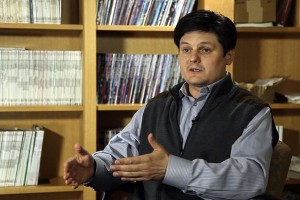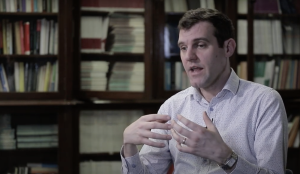Allelic Architecture of Complex Traits
Geneticist Shamil Sunyaev on the difference between Mendelian and complex traits, linkage methods in genetics,...
How do we come to be? How do we develop from a single cell buried in our mothers’ wombs into an embryo, a fetus, an infant and then, finally, an adult? It’s one of the great questions of biology. In principle, the answer is relatively straightforward: that process is controlled by a genetic program, something like a computer program but one that runs on genes in which there are cascades of genetic information, in which one gene switches on another gene, switches on other genes, on and off in ramifying networks in which specify the different parts of our body. But how?
All the information is there in our genomes. We’ve known it since 2001, when the human genome was sequenced. It was a great, great result, and there it was in front of us as it were the book for making a human being, the instruction manual. The problem was that the instruction manual was written in a language that we didn’t understand; it was written in Chinese (assuming that you’re not Chinese and can’t read it). And so, our task as biologists has been to understand the grammar and vocabulary of genes. The way to do that is brutally straightforward.
If you have 25,000 genes and you don’t know what they do and you want to know what they do, you just start knocking them out, you remove one of them. The logic is exactly as if a Martian were to encounter a car and he wanted to know how does the car work. So he begins to take the car to pieces, he unscrews something. Sometimes he takes out a screw and a wing mirror falls off, and the Martian says, well, obviously the purpose of that screw was to attach the wing mirror to the car. Sometimes the car just dies, and the Martian says, well, clearly that screw was needed for the life of the car, to have the thing work at all.
That’s exactly what biologists do: they knock out genes one after another in order to find out what they are and what they do, and they look at the result. It’s a sort of reverse engineering approach. They look for mutations and engineer mutations: they do it to the mice, they do it to fruit flies… I used to study worms, and we looked at mutant worms all the time.
There are disorders, large and small, innumerable. The last time I looked a few years ago, there were around 30,000 genetic disorders named in a database which is maintained by the National Institutes of Health in the USA, and each of them is caused by a mutation in at least one gene. These are very discrete kinds of disorders; they’re the sort of disorders that you can identify discreetly, that are inherited in Mendelian fashion. So I’m not talking about the complicated diseases like diabetes and heart disease and so forth: I’m talking about the things that are really strikingly passed down from one generation to the next in a dominant or recessive fashion.
We don’t actually realize just how fragile the human body is, how fragile children are, how many of us are messed up in one way or another, and the reason is because there are so many diseases. So many children are wrong in one way or another but we never actually count the burden of mutation upon ourselves. It’s immense, it’s huge. When I contemplate it, I’m amazed that any of us turned out even remotely alright.
But given that we don’t, it turns out that it’s hugely informative: it tells us about how the human body is built. Let me give you an example: there’s a disorder called cyclopia. Cyclopia is named for Cyclops, the monster of antiquity from Homer. They were a race of giants who built the great walls which were encountered in the Bronze Age, and they were vastly bigger than humans; they were giants. They had a single eye in the middle of their foreheads. Odysseus kills one of them, but they crop up all over the place. If you follow their iconography, they come closer and closer and smaller and smaller, and they come closer to home, and so finally, they appear at the beginning of the Scientific Revolution in books of teratology, books of monsters. But these are books of actual babies that are born. Leonardo da Vinci illustrates one of them, or at least it’s attributed to him, and it’s just a little girl who got a single eye in the middle of her forehead who was born in Florence at that time. They’re still being born.
Why is it called Sonic Hedgehog? Well, this is just molecular biology humour. There’s a gene in Drosophila, in fruit flies called Hedgehog, and it turns out that a relative of that gene was found in humans, so the molecular biologists called it Sonic Hedgehog after the video game character Sonic the Hedgehog. But it turns out to be one of the most important genes. It encodes a protein that makes signals working over different parts of our bodies, but most especially, most famously, it controls the width of our faces. That is the reason that our faces are the width that they are, some a little bit more and a little bit less. It’s simply because we have the right amount of sonic hedgehog signalling in our faces when we were an embryo. If you experimentally manipulate this in ducks or chicks, you can cause the face to expand and expand so much until it actually duplicates and you’re gonna get two noses and two pairs of eyes completely far apart, or in the case of a mutant pig that was found which had almost two completely separate faces side by side. The pig was called Ditto.
That’s an example of how teratology, abnormality, and disorder tell us just one little part about how the human body is built; it tells us that this gene is needed for regulating our faces. You can tell a thousand stories like that, using what we are learning from human geneticists about all the genes that underlie all the abnormalities in the world to describe the genetic program that makes us, our hands or any other part of our bodies.
Although I spoke about mutants as other people, you should never forget that that’s wrong because the mutants aren’t others, the mutants are us. We are all mutants. I estimated some years ago and this has been borne out by more modern analyses that the average child, the average baby that is born is afflicted with something like 300 mutations that cause it to be less healthy than it might be otherwise. So we are all riddled with them.
Most of them, fortunately, only decrease our fitness or our health in small ways. It’s only when they become really life-threatening that we actually notice them, that they become medicalized, that they become the kinds of disorders that I’ve spoken about. But the truth is I think that the burden of mutation is one of the fundamental things that control the way we perceive other people.
So I think, I speculate, I hypothesise that this variation in our mutational burden is also the essence of physical beauty. What is it about physical beauty that captures us, that takes us by surprise, that causes us to look? If I am right, it’s not that beauty is a positive thing; some God-given quality the beautiful people have that the rest of us don’t. Rather it is simply an assessment of the absence of imperfections. We have, as it were, some ideal in our heads; we probably all have very much the same ideal, and as it were, when we look at someone, we ask, how far is that person from the ideal? We just take off points for every imperfection that they have, and when we cannot remove points, then we say there is beauty. Stendhal said beauty is the promise of happiness, and I understand what it means, but I actually really think that it is the recollection of sorrow.

Geneticist Shamil Sunyaev on the difference between Mendelian and complex traits, linkage methods in genetics,...

Neuropsychologist Barbara Sahakian on risky decision-making, two forms of cognition that people use, and the ...

Meteorologist Chris Brierley on the history of Earth and natural climate cycles